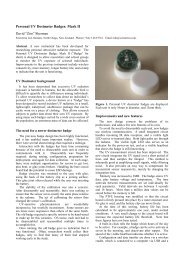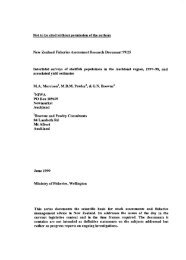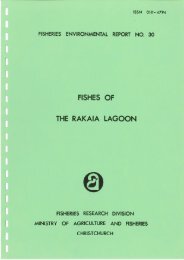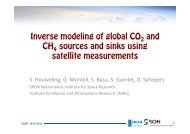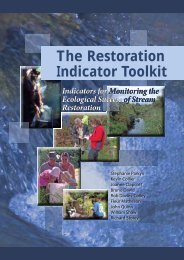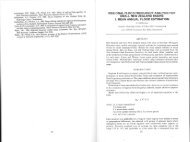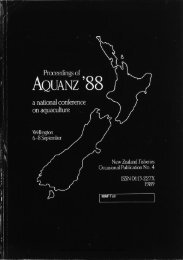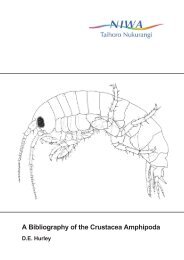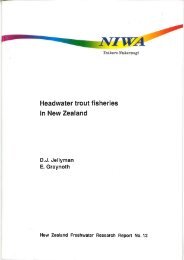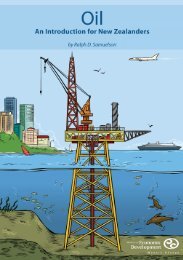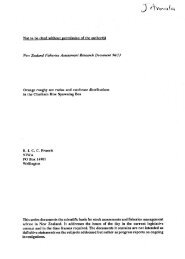WATER & SOIL - These are not the droids you are looking for.
WATER & SOIL - These are not the droids you are looking for.
WATER & SOIL - These are not the droids you are looking for.
You also want an ePaper? Increase the reach of your titles
YUMPU automatically turns print PDFs into web optimized ePapers that Google loves.
annual flood Q (<strong>the</strong> mean of <strong>the</strong> annual peaks). Q<br />
may be estimated from measured catchment and<br />
climatic characteristics. This is <strong>the</strong> method used in<br />
this study. It is also known as <strong>the</strong> index flood<br />
method. A<strong>not</strong>her version of <strong>the</strong> method relates Q1<br />
directly to catchment and climatic characteristics.<br />
It is pertinent to review <strong>the</strong> development of all <strong>the</strong>se<br />
techniques in <strong>the</strong> New Zealand context.<br />
1.3.1 Empirical Methods<br />
Early flood estimation methods involved fitting an<br />
envelope curve to observed extremes <strong>for</strong> a region to give an<br />
empirical estimate of a maximum flood, usually with catchment<br />
<strong>are</strong>a as a parameter (Schnackenberg, 1949). Envelope<br />
curve methods have been largely replaced by empirical<br />
methods involving probability; of <strong>the</strong>se <strong>the</strong> best known <strong>are</strong><br />
<strong>the</strong> Rational Method and Technical Memorandum No. 6l<br />
(TM6l) (NWASCO l97s).<br />
Although <strong>the</strong> Rational Method is in wide use, it is <strong>not</strong> an<br />
accurate deterministic description of <strong>the</strong> way in which a<br />
catchment modifies rainfall to yield <strong>the</strong> peak runoff<br />
(French et al. 1974). An alternative and useful interpretation<br />
of <strong>the</strong> Rational Method is statistic¿l. Here <strong>the</strong> method<br />
links runoff rates of given frequencies with rainfall rates of<br />
<strong>the</strong> same frequencies as follows:<br />
Qr = C.Pt. A/3.6<br />
where<br />
qt: peak discharge rate of return period T (m¡,zs)<br />
Pt = <strong>the</strong> design rainfall rate (mm/hr) <strong>for</strong> a storm of return<br />
period T and duration t equal to <strong>the</strong> time of concentration<br />
<strong>for</strong> <strong>the</strong> catchment<br />
A = <strong>the</strong> catchment <strong>are</strong>a (km,)<br />
C = an empirical coeffìcient which provides <strong>the</strong> link between<br />
peak runoff and peak rainfall. It embodies <strong>the</strong><br />
net effect of catchment losses, storage effects, etc.<br />
French et al. (1974) showed that <strong>the</strong> coefficient C increases<br />
somewhat with <strong>the</strong> return period T, and gave<br />
typical values <strong>for</strong> central and south-east New South Wales.<br />
Aitken (1975) found this ratio <strong>for</strong> a catchment to be<br />
essentially constant <strong>for</strong> different return periods. For urban<br />
catchments Schaake et al. (1967) suggested C could be<br />
estimated as a function of <strong>the</strong> portion of impervious <strong>are</strong>a in<br />
<strong>the</strong> catchment and <strong>the</strong> slope of <strong>the</strong> main channel.<br />
The second quantity requiring estimation is <strong>the</strong> duration<br />
of <strong>the</strong> design rainstorm. The critical duration is closely approximated<br />
by <strong>the</strong> minimum tirne of rise <strong>for</strong> a number of<br />
hydrographs, <strong>These</strong> <strong>are</strong> <strong>not</strong> available <strong>for</strong> ungauged catchments<br />
and traditional time of concentration <strong>for</strong>mulae <strong>are</strong><br />
<strong>not</strong> reliable. Heiler (1974) developed an estimator <strong>for</strong> this<br />
time constant <strong>for</strong> catchments of peninsular Malaysia. Once<br />
a duration is established, storm rainfall can be estimated,<br />
and in Heiler's case C was estimated as a function of rainfall<br />
intensity; application of <strong>the</strong> method was restricted to<br />
catchments with <strong>are</strong>as in <strong>the</strong> range I km, to 100 kmr. Adaptation<br />
of this statistical interpretation of <strong>the</strong> Rational<br />
Method <strong>for</strong> New Zealand conditions would be a valuable<br />
contribution.<br />
A<strong>not</strong>her well-known empirical method in New Zealand<br />
is known by its publication number, TM6l (NWASCO<br />
1975) and is an adaptation of various American methods.<br />
It is recommended <strong>for</strong> catchment <strong>are</strong>as up to 1000 kmr.<br />
The method is;<br />
Qr = 0.0139 CRSA%<br />
where<br />
C = coefficient dependent on <strong>the</strong> physiography of <strong>the</strong><br />
catchment,<br />
R = rainfall factor dependent on <strong>the</strong> design storm,<br />
S = catchment shape factor,<br />
A : catchment <strong>are</strong>a (km'z),<br />
The factor C is determined as <strong>the</strong> product of two factors<br />
ìV¡s and Ws. Wlc is determined from a table which has soil<br />
type and surface cover as parameters, and W5 is obtained<br />
from a graph having channel length and slope as<br />
parameters. R is <strong>the</strong> ratio of <strong>the</strong> design rainfall <strong>for</strong> <strong>the</strong> catchment<br />
to <strong>the</strong> adjusted standard rainfall at Kelburn, Wellington.<br />
As with <strong>the</strong> Rational Method, <strong>the</strong> rainfall duration<br />
must be determined by an empirical time of concentration<br />
<strong>for</strong>mula. The shape factor is a function of <strong>the</strong> catchment<br />
<strong>are</strong>a and length. The development of <strong>the</strong> method is discussed<br />
by Campbetl (1959). When first introduced in 1953 this<br />
method met an urgent need <strong>for</strong> a standard procedure <strong>for</strong><br />
flood estimation <strong>for</strong> ungauged catchments. Its value was<br />
greatly enhanced by <strong>the</strong> publication of a probability<br />
analysis of high intensity rainfalls (Robertson 1963).<br />
1.3.2 Un¡t hydrograph methods<br />
The unit hydrograph method developed in <strong>the</strong> 1930's has<br />
become a widely used hydrological tool. The unit<br />
hydrograph (UH) is <strong>the</strong> flow record from a saturated catchment<br />
when a unit of rainfall falls uni<strong>for</strong>mly <strong>for</strong> unit time.<br />
As part of each storm is required to saturate <strong>the</strong> soil, <strong>the</strong><br />
UH represents only <strong>the</strong> "quickflow".<br />
The quickflow from a rainfall excess of various amounts<br />
over a succession of time units is calculated by superposition<br />
of <strong>the</strong> set of unit hydrographs that correspond to <strong>the</strong><br />
rainfall excess. Thus <strong>the</strong> catchment is assumed to respond<br />
linearly, in that runoff from a particular portion of storm<br />
rainfall is unaffected by concurrent runoff from o<strong>the</strong>r portions<br />
of <strong>the</strong> storm. <strong>These</strong> assumptions have been tested in<br />
numetous studies and <strong>for</strong> small and medium sized catchments<br />
have been found adequate <strong>for</strong> most engineering<br />
design purposes. With a UH determined from a number of<br />
storms and <strong>for</strong> average ratios of excess to total rainfall,<br />
design floods <strong>for</strong> a catchment can be estimated from design<br />
storms of <strong>the</strong> same probability. An important advantage of<br />
this versatile method over those described previously is that<br />
<strong>the</strong> shape of <strong>the</strong> flood hydrograph is calculated, and <strong>not</strong><br />
merely <strong>the</strong> peak rate of flow; this is of importance in<br />
routing studies, in drainage design and in o<strong>the</strong>r situations<br />
where it is necessary to know <strong>the</strong> length of time <strong>the</strong> water<br />
level is above a particular stage. Possibly <strong>the</strong> main limitation<br />
of <strong>the</strong> method is <strong>the</strong> subjectivity in determining <strong>the</strong><br />
volume and distribution of <strong>the</strong> rainfall excess. Where <strong>the</strong><br />
lack of flow records prevent <strong>the</strong> derivation of <strong>the</strong> UH, procedures<br />
have been developed <strong>for</strong> syn<strong>the</strong>sising typical UH<br />
curves by relating characteristics of <strong>the</strong> hydrograph shape<br />
to catchment characteristics. <strong>These</strong> procedures include <strong>the</strong><br />
well-known Snyder method and <strong>the</strong> US Soil Conservation<br />
Service dimensionless hydrograph (Linsley et al. 1975),<br />
<strong>These</strong> methods have been used successfully within two<br />
regions of similar hydrological characteristics (Hoffmeister<br />
1976). Also <strong>the</strong> Snyder method gave satisfactory results <strong>for</strong><br />
ungauged tributaries <strong>for</strong> <strong>the</strong> Waikato and Clutha Rivers<br />
(Jowett and Thompson 1977), although Coulter (1961)<br />
queries <strong>the</strong> wide applicability of <strong>the</strong> methods.<br />
A guide to <strong>the</strong> order of loss rates that should be used is<br />
given by Pilgrim (1966), who summarised published loss<br />
rate in<strong>for</strong>mation in New Zealand,. As most loss rates were<br />
low (5090 of loss rates were less than 2.5 mm/hr and 8090<br />
were less than 5.1 mm/hr), it was concluded that <strong>the</strong> inaccuracies<br />
in transferring <strong>the</strong>se values from one region to<br />
a<strong>not</strong>her should cause only very small errors in design<br />
floods. Never<strong>the</strong>less, more work is needed on loss rate<br />
estimation in New Zealand as loss rates <strong>are</strong> important in<br />
situations where flow <strong>for</strong>ecasts <strong>are</strong> required. For tributaries<br />
in <strong>the</strong> Motueka catchment Beable (1976) found loss rates to<br />
be related to antecedent wetness, storm intensity and <strong>the</strong><br />
portion of catchment in exotic <strong>for</strong>estry.<br />
1.3.3 Simulation methods<br />
Under this heading is grouped a variety of methods <strong>for</strong><br />
representing catchment response to precipitation. Cat-<br />
Water & soil technical publication no. 20 (1982)



